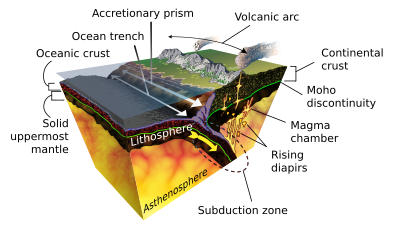
Back Vulkaanboog Afrikaans قوس بركاني Arabic Arc volcànic Catalan Vulkanarko Esperanto Arco volcánico Spanish Vulkaaniline kaar Estonian Arku bolkaniko Basque کمان آتشفشانی Persian Arc volcanique French Arco volcánico Galician

A volcanic arc (also known as a magmatic arc[1]: 6.2 ) is a belt of volcanoes formed above a subducting oceanic tectonic plate,[2] with the belt arranged in an arc shape as seen from above. Volcanic arcs typically parallel an oceanic trench, with the arc located further from the subducting plate than the trench. The oceanic plate is saturated with water, mostly in the form of hydrous minerals such as micas, amphiboles, and serpentines. As the oceanic plate is subducted, it is subjected to increasing pressure and temperature with increasing depth. The heat and pressure break down the hydrous minerals in the plate, releasing water into the overlying mantle. Volatiles such as water drastically lower the melting point of the mantle, causing some of the mantle to melt and form magma at depth under the overriding plate. The magma ascends to form an arc of volcanoes parallel to the subduction zone.
Volcanic arcs are distinct from volcanic chains formed over hotspots in the middle of a tectonic plate. Volcanoes often form one after another as the plate moves over the hotspot, and so the volcanoes progress in age from one end of the chain to the other. The Hawaiian Islands form a typical hotspot chain, with the older islands to the northwest and Hawaii Island itself, which is just 400,000 years old, at the southeast end of the chain over the hotspot. Volcanic arcs do not generally exhibit such a simple age-pattern.
There are two types of volcanic arcs:
- intraoceanic arcs (primitive arcs) form when oceanic crust subducts beneath other oceanic crust on an adjacent plate, creating a volcanic island arc.
- continental arcs form when oceanic crust subducts beneath continental crust on an adjacent plate, creating an arc-shaped mountain belt.
In some situations, a single subduction zone may show both aspects along its length, as part of a plate subducts beneath a continent and part beneath adjacent oceanic crust. The Aleutian Islands and adjoining Alaskan Peninsula are an example of such a subduction zone.
The active front of a volcanic arc is the belt where volcanism develops at a given time. Active fronts may move over time (millions of years), changing their distance from the oceanic trench as well as their width.
- ^ Stern, Robert J. (December 2002). "Subduction zones". Reviews of Geophysics. 40 (4): 3–1–3–38. Bibcode:2002RvGeo..40.1012S. doi:10.1029/2001RG000108. S2CID 15347100.
- ^ "Volcanic arc definition from the Dictionary of Geology". Retrieved 2014-11-01.